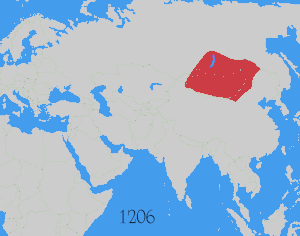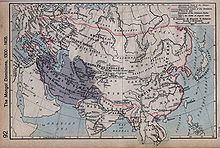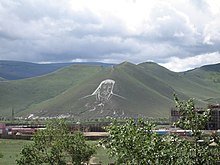The establishment of the Yuan dynasty (1271–1368) by Kublai Khan accelerated the fragmentation of the Mongol Empire. The Mongol Empire fractured into four khanates including the Yuan dynasty in China and Mongolia, and the three western khanates, i.e. the Golden Horde, the Chagatai Khanate and the Ilkhanate, although later Yuan emperors were seen as the nominal suzerains of the western khanates.
The transition of the capital of the Mongol Empire from Karakorum to Khanbaliq (Dadu, modern-day Beijing) by Kublai Khan in 1264 was opposed by many Mongols. Thus, Ariq Böke's struggle was for keeping the center of the Empire in Mongolia homeland. After Ariq Böke's death, the struggle was continued by Kaidu, a grandson of Ogedei Khan and de facto ruler of the Chagatai Khanate until 1301 as well as lord Nayan in 1287, although the Mongolian steppe was controlled by Kublai Khan and his successors after the Toluid Civil War.
Kublai invited lama Drogön Chögyal Phagpa of Sakya school of Tibetan Buddhism to spread Buddhism throughout his realm (the second introduction of Buddhism among the Mongols). Buddhism became the de facto state religion of the Mongol Yuan state. In 1269, Kublai Khan commissioned Phagpa lama to design a new writing system to unify the writing systems of the multilingual empire. The 'Phags-pa script, also known as the "Square script", was based on the Tibetan script and written vertically from top was designed to write in Mongolian, Tibetan, Chinese, Uighur and Sanskrit languages and served as the official script of the empire.
Kublai Khan announced the establishment of the Yuan dynasty in 1271. The Yuan dynasty included Mongolia homeland, the territories of the former Jin and Song dynasties and some adjacent territories such as a major part of southern Siberia. Kublai established a government with institutions resembling the ones in earlier Chinese dynasties such as the Zhongshu Sheng to lead the civil administration in the Yuan realm, yet at the same time introduced a hierarchy of reliability by dividing the subjects of the Yuan dynasty into 4 ranks. The highest rank included the Mongols, the second rank included the peoples to the west of Mongolia, the third rank included the subjects of the former Jin dynasty such as Northern Chinese, the Khitans and Jurchens, and the lowest rank comprised the subjects of the former Song dynasty such as the Han ethnic group in South China.
As for Mongolia itself, since the Mongolian Plateau is where the ruling Mongols of the Yuan dynasty came from, it enjoyed a somewhat special status during the Mongol Yuan dynasty, although the capital of the dynasty had been moved from Karakorum to Khanbaliq (modern Beijing) since the beginning of Kublai Khan's reign, and Mongolia had been turned into a province known as the Lingbei Branch Secretariat by the early 14th century. After the capture of the Yuan capital by the Ming dynasty founded by Han Chinese in 1368, the last Yuan emperor Toghon Temür fled north to Shangdu, then to Yingchang and died there in 1370. The Mongols under his son and successor Biligtü Khan Ayushiridara retreated to the Mongolian steppe and fought against the Ming. Mongolia homeland became the ruling center of the Northern Yuan dynasty which would last until the 17th century.











